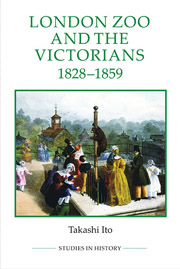Book contents
- Frontmatter
- Contents
- List of figures
- List of tables
- Acknowledgements
- Abbreviations
- Dedication
- Introduction: the zoo in history
- 1 The site of animal spectacle
- 2 Collecting and displaying
- 3 The question of access
- 4 Between science and commerce
- 5 Illusionary empire
- Conclusion: the Darwinian moment
- Appendix
- Bibliography
- Index
Introduction: the zoo in history
Published online by Cambridge University Press: 05 April 2014
- Frontmatter
- Contents
- List of figures
- List of tables
- Acknowledgements
- Abbreviations
- Dedication
- Introduction: the zoo in history
- 1 The site of animal spectacle
- 2 Collecting and displaying
- 3 The question of access
- 4 Between science and commerce
- 5 Illusionary empire
- Conclusion: the Darwinian moment
- Appendix
- Bibliography
- Index
Summary
The path beyond the entrance gate to London's Zoological Gardens led to a long promenade lined with ornamental shrubs. At the far end bears were exhibited in a deep square pit, as depicted by George Scharf in one of his Six views of the Zoological Gardens (see cover illustration). Here a gentleman holds out a long stick with a bun stuck on the end, while the bear has climbed up a stout wooden pole. The spectators expect the bear to reach out and grab the bun. Contemporary commentators often described animal behaviour in analogy with human nature. In 1829 Toby the Russian black bear, who often had proffered food snatched away from him by two polar bears, was compared in one guidebook to ‘good-natured men who are mastered by those of rough natures’. This was a prime example of public interaction with nature presented as spectacle – a scene that sets the stage for this book on the London Zoo, which debates cultural politics, public science and the meaning of the animal world in nineteenth-century Britain. The scene at the bear pit spotlights the multifaceted nature of the zoo.
Although the development of zoos in nineteenth-century Europe and America has recently attracted scholarly attention, it is still necessary to clarify why the subject is important. A number of zoos today are challenged by those who criticise the caging of animals and are denounced as an institutional impediment to the protection of animal welfare.
- Type
- Chapter
- Information
- London Zoo and the Victorians, 1828-1859 , pp. 1 - 20Publisher: Boydell & BrewerPrint publication year: 2014

